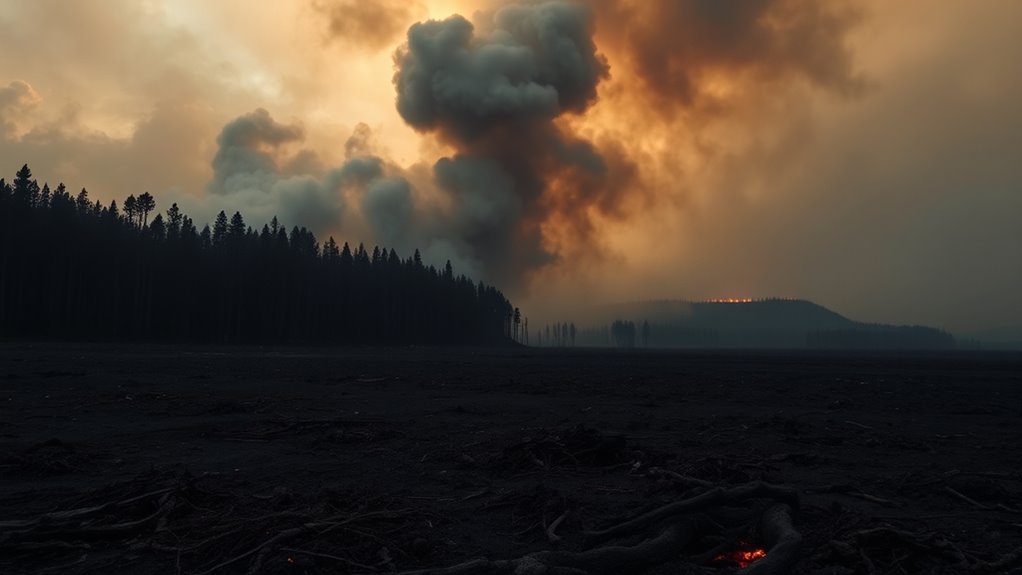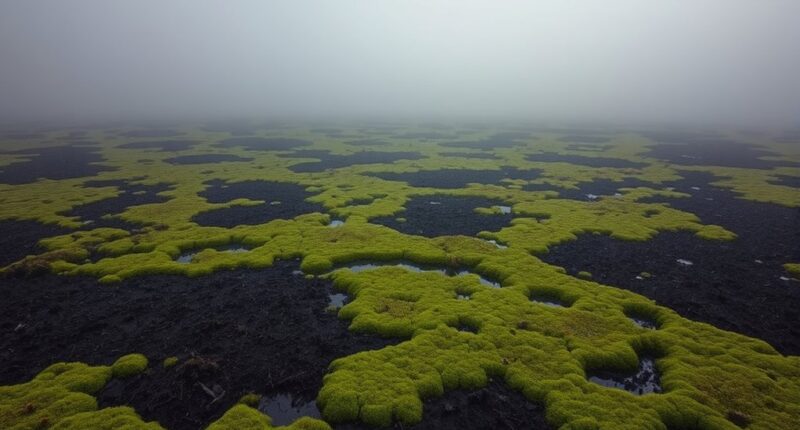Scientists warn that “smokeless” wildfires fueled by underground peat reserves pose a hidden yet serious threat to your climate and ecosystems. These fires burn beneath the surface with little to no smoke, making them hard to detect and control. They release large amounts of greenhouse gases, worsening global warming and ecosystems’ health. As temperatures rise and droughts intensify, these fires are likely to become more frequent and severe. Keep exploring to uncover how these silent blazes impact our world.
Key Takeaways
- Peat fires burn underground with little visible smoke, making detection and monitoring challenging for scientists.
- These fires release significant greenhouse gases like carbon dioxide and methane, accelerating climate change.
- Conventional firefighting methods are ineffective; specialized techniques are required to control smokeless peat fires.
- Rising temperatures and droughts increase the frequency, intensity, and duration of these hidden wildfires.
- Smokeless peat fires pose underestimated environmental risks, threatening ecosystems and contributing to global warming.

Scientists are raising alarms about a new threat: “smokeless” wildfires fueled by vast peat reserves that burn underground. Unlike traditional wildfires, these fires produce little to no visible smoke, making them harder to detect and monitor. Peat fires occur when the organic material in peatlands ignites and smolders beneath the surface, often smoldering for months or even years. Because they burn underground, they don’t generate the towering flames and billowing smoke clouds you’re accustomed to seeing in forest fires. Instead, they quietly consume the peat, releasing significant amounts of greenhouse gases like carbon dioxide and methane into the atmosphere.
Undetectable underground peat fires silently release greenhouse gases, worsening climate change and threatening ecosystems worldwide.
You might think that the absence of smoke means these fires are less dangerous, but that couldn’t be further from the truth. Peat fires contribute substantially to global warming because they release stored carbon that has accumulated over centuries. Their smoke emissions, although less visible, are still potent sources of air pollution. These emissions contain fine particulate matter and toxic gases that can affect air quality over large areas, impacting human health and ecosystems alike. Because the smoke is less visible, many communities and firefighting agencies overlook or underestimate the threat posed by peat fires, allowing them to spread quietly and persist for long periods.
You should be concerned because these fires are incredibly difficult to control. While surface fires can be snuffed out with standard firefighting techniques, underground peat fires require specialized methods, such as flooding or excavation, which are often impractical on a large scale. The fires can smolder beneath the surface for months or years, reigniting surface fires or spreading silently beneath the ground. This makes them particularly insidious, as they can flare up suddenly, causing unexpected outbreaks even after initial suppression efforts.
Furthermore, climate change is exacerbating the problem. Warmer temperatures and prolonged droughts create ideal conditions for peat fires to ignite and persist. As the climate warms, these underground fires are likely to become more frequent and severe, releasing even more greenhouse gases into the atmosphere. You may not see the flames or smoke, but the impact is real and far-reaching — fueling global warming, degrading air quality, and threatening local ecosystems. Recognizing the danger of these smokeless fires is essential for developing effective detection and mitigation strategies, especially as traditional firefighting methods fall short against this hidden threat.
Frequently Asked Questions
How Can Communities Prepare for Smokeless Peat Wildfires?
You should prepare for smokeless peat wildfires by creating a community evacuation plan and practicing it regularly. Keep firefighting equipment accessible and well-maintained, including tools suited for underground fires. Educate residents about peat fire risks and signs. Coordinate with local authorities to ensure quick response times. Staying informed and ready helps protect your community from these hidden, intense fires that can spread rapidly underground.
What Long-Term Ecological Impacts Do These Wildfires Cause?
Did you know that peatland degradation accounts for about 5% of global greenhouse gas emissions? Long-term ecological impacts of these wildfires include significant biodiversity loss, as many species depend on intact peatlands. These fires also cause persistent habitat destruction, making recovery slow and difficult. Over time, the degradation worsens, reducing ecosystem resilience and disrupting carbon storage, which amplifies climate change effects and hampers efforts to restore healthy, diverse environments.
Are Current Firefighting Techniques Effective Against Peat Fires?
You might find that current firefighting techniques often struggle against peat fires because fire suppression methods aren’t always effective in smoldering, underground peat layers. Firefighting technology is improving, but peat fires require specialized approaches like drainage and controlled burnouts. While these methods help, they still pose challenges due to the persistent and hidden nature of peat, making it harder to fully contain and extinguish these wildfires quickly.
How Do Peat Fires Influence Local Climate Change?
Peat fires considerably influence local climate change by releasing large amounts of carbon emissions through peat ignition. When you encounter these fires, know that they release stored carbon into the atmosphere, trapping heat and accelerating warming. Unlike typical wildfires, these smoldering fires can burn underground for long periods, increasing their impact on climate change. Your awareness and action can help reduce the spread and effects of peat-related wildfires.
What Policy Measures Are Recommended to Prevent Peat Wildfires?
You should support and implement fire prevention policies focused on peatland conservation. These policies might include creating buffer zones, restricting land use changes, and promoting controlled burns to reduce fire risk. Additionally, enforcing strict regulations on peat extraction and educating communities about fire hazards can help prevent wildfires. By prioritizing these measures, you contribute to protecting peatlands, reducing smoke emissions, and mitigating climate change impacts caused by wildfires.
Conclusion
You must realize these smokeless wildfires are like silent predators lurking beneath the surface, quietly fueling destruction. Ignoring the threat of peat fires means risking a future where flames burn unseen but leave scars just as deep. Stay alert and support efforts to monitor and protect these essential reserves. Only then can we prevent a hidden inferno from igniting chaos and safeguarding our environment from this stealthy menace.








